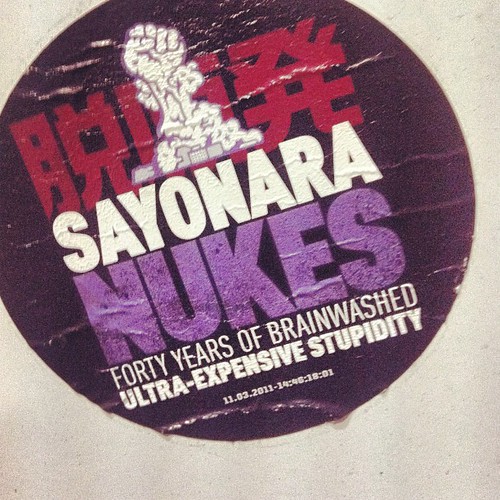Event headliner, the Inoue Ohana band
Musicians
have long been known for offering some of the most cutting-edge and creative
social critique around the globe, and Japan is no exception—particularly with
regard to post-3.11 nuclear issues.
This
past Sunday, November 25th, a No Nukes live event was held at Shin Sekai ("New World"), a
small basement club in Tokyo’s Nishi-Azabu district, taking up the tradition of
other local event series that have combined music with commentary on nuclear
issues, including No Nukes More Hearts and Atomic Café.
The
event was organized and headlined by the fantastically upbeat Inoue Ohana band,
which features both Hawaiian and reggae tunes. The night’s lineup also featured
many additional artists, including slack key guitarist Kamoku Takahashi, folk
singer Yara Tomonobu, hula dancer Miho Ogura, and the legendary Rankin’ Taxi,
whose video “You Can’t See It and You Can’t Smell It”(referring of course to
radiation) went viral in the weeks following the Fukushima nuclear disaster.
The
evening was billed as a “party”, and—capturing the spirit of the evening— the
ever rabble-rousing Rankin’ Taxi followed up his performance of a song
regarding the dangers of the precariously placed fuel rods at Fukushima Daiichi
plant’s reactor #4 (whose video I had technical problems uploading—will try
again shortly!) by commenting—in his trademark quirky and yet serious style— “Well,
we shouldn’t really be having fun at a time like this, but hey, let’s have
ourselves some fun!”
Each
of the evening’s artists took time to reference the dangers of the nuclear
power industry. Guest speaker Umi Hagitani, a social activist for numerous
causes including nuclear issues, gave an illuminating overview of the workings
of the nuclear industries and anti-nuclear activism in both Japan and the USA,
where she has spent most of the past decade.
To
summarize the highlights of Umi’s talk, she emphasized that we must consider
nuclear issues as a whole, taking into account its various aspects, including
uranium mining and testing, and the effects on (often indigenous) communities;
as well as the interconnections between nuclear power, weapons, and testing,
which are often overlooked in both countries. She pointed out that the
mainstream media in the U.S. suppressed the voices speaking out against
Three-Mile Accident in 1979, and that the government began almost immediately thereafter to promote
the construction of nuclear power plants in other regions of the country—resulting
in continuing environmental and health damage, along with citizen unawareness
regarding what was actually taking place. She pointed in particular to the
nuclear facility in Hanford, WA—profiled in filmmaker Hitomi Kamanaka’s
“Hibakusha”—where radiation dating back to the early 1940’s has penetrated all
the way down into the water table, causing numerous cancers (that were denied
by the government as having any connection with the plant).
Umi
pointed out the borderless nature of damage from the Fukushima nuclear accident,
explaining that cesium is now showing up in Pacific herring in Alaska, which
indicates that internal radiation exposure is something not limited to
Fukushima or to Japan alone. She also asserted that lying governments and
complicit media are a shared feature of both the United States and Japan,
explaining that since 3-.11, anti-nuclear activists from the two countries have
been working together to expose the way that the nuclear industry has been
working to pollute the land where we live, while companies meanwhile continue profiting
from decontamination efforts, and governments attempt to quash any citizen
movements that speak out against negative effects such as rising illnesses and
human experimentation.
“I
recently watched ‘Women of Fukushima’, where one of the speakers said that if
people in Tokyo did not begin speaking out about low-dose radiation exposure
suffered by Fukushima citizens, their situation would never change,” Umi
explained. “Given our privilege living in urban areas with access to all sorts
of technologies, we need to raise our voices against these unjust systems by
continuing to advocate for Fukushima citizens’ right to relocation, to support
Fukushima citizen radiation efforts, and to educate ourselves regarding nuclear-related
matters,” she said.






